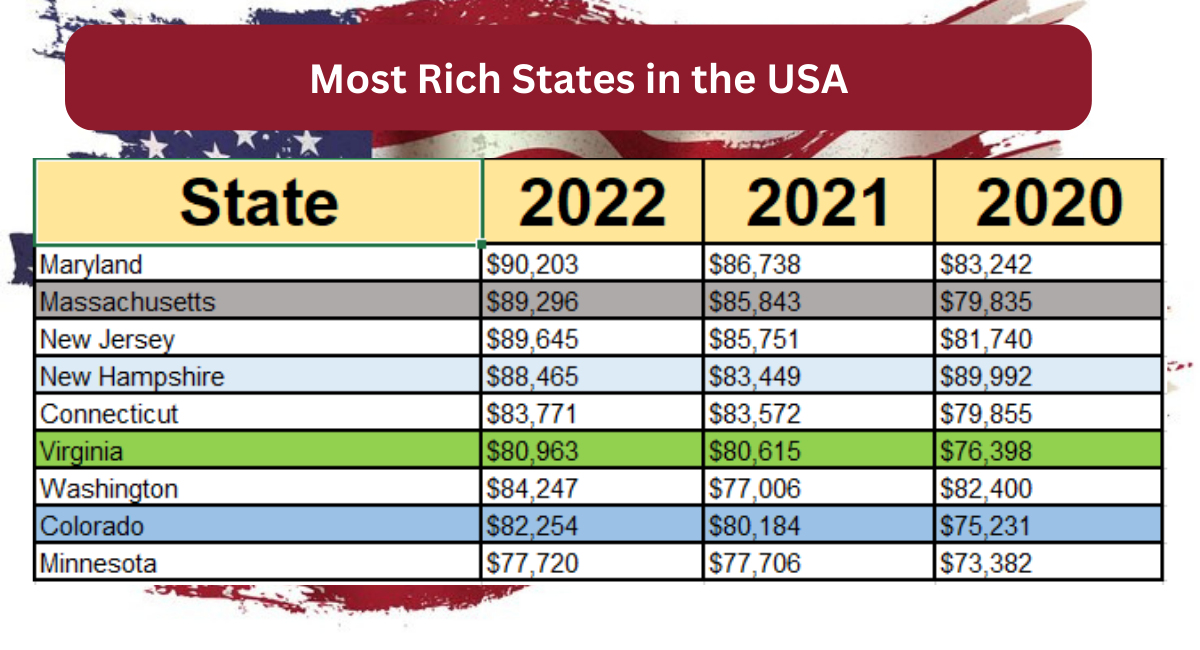10 Most Rich States in the USA in 2024
A diverse array of states marks the economic landscape of the United States, each contributing uniquely to the nation’s prosperity. Among these states, a handful emerge as wealth leaders, boasting strong economies and high living standards. From California’s tech hubs to New York’s financial centers, these states exemplify economic success on a national scale.
Before we delve deeper into the richest states in the USA, it’s important to understand two key measures: gross domestic product (GDP) and median household income. GDP represents the aggregate value of goods and services produced within a state’s boundaries over a specified period, typically annually. It serves as a barometer of a state’s overall economic output, encompassing contributions from diverse sectors spanning industries, enterprises, and individuals. States boasting high GDP figures often exhibit expansive and diversified economies underpinned by robust industrial, commercial, and service sectors.
Conversely, median household income denotes the midpoint value of all household incomes within a state, with half of households earning more and half earning less. This metric illuminates the distribution of income within a state and offers insights into the economic well-being of its populace. States with elevated median incomes typically feature a prevalence of well-compensated occupations, affluent communities, and an elevated quality of life.
By examining these metrics, we will gain a deeper understanding of the economic health and vitality of the wealthiest states in the USA. Through this analysis, we aim to uncover the factors driving their success and the implications for national prosperity.
Also Read: Most Dangerous Cities in the US
A List of Top 10 Wealthiest States in America (by GDP)
This list contains the richest states in the United States, ranked by GDP. These states epitomize economic strength, boasting diverse sectors, robust infrastructures, and flourishing economies that significantly enhance the nation’s overall prosperity.
- California
- Texas
- New York
- Florida
- Illinois
- Pennsylvania
- Ohio
- Georgia
- North Carolina
- Virginia
1. California
California’s economic significance stems from its diverse industries and innovative spirit. The state’s crown jewel, Silicon Valley, situated in the San Francisco Bay Area, is globally renowned as the epicenter of technology and entrepreneurship. Companies like Apple, Google, and Facebook have not only revolutionized the tech landscape but also exerted considerable influence on the global economy. Moreover, California dominates the entertainment industry with Hollywood, shaping popular culture through cinema, television, and music.
Beyond technology and entertainment, California boasts a thriving agricultural sector, ranking as one of the top agricultural producers in the nation. Its favorable climate and fertile soil support the cultivation of a wide range of crops, contributing significantly to the state’s GDP. Additionally, California’s picturesque landscapes and diverse climates attract millions of tourists annually, further boosting its economic prosperity through revenue generated from tourism-related activities, including hospitality, leisure, and retail sectors.
2. Texas
Texas’ economic vitality is anchored in its robust energy sector, particularly oil and natural gas production. The state is home to significant reserves of fossil fuels, making it a major player in the global energy market. Moreover, Texas has embraced renewable energy sources such as wind and solar power, diversifying its energy portfolio and contributing to its economic resilience.
In addition to energy, Texas has a favorable business environment characterized by low taxes, minimal regulations, and ample land, attracting a diverse array of industries. Major cities like Houston, Dallas, and Austin serve as economic powerhouses, fostering growth across sectors including technology, aerospace, healthcare, and finance. Furthermore, Texas’ strategic location and well-developed infrastructure, including the Port of Houston, one of the busiest ports in the United States, facilitate international trade, enhancing the state’s economic prosperity.
3. New York
New York’s economic prominence is deeply rooted in its global reputation as a financial powerhouse, notably centered around Wall Street in Manhattan. The concentration of major financial institutions and stock exchanges in this area solidifies New York’s status as the epicenter of global finance, facilitating an immense flow of capital and investment activity worldwide. However, New York’s economic strength extends far beyond the financial sector.
The state boasts a diverse and robust economy characterized by a thriving ecosystem of industries. Beyond finance, sectors such as media, technology, healthcare, and tourism play significant roles in driving economic growth and innovation. New York City, as the largest metropolitan region in the United States, serves as a magnet for both businesses and tourists, contributing substantially to the state’s economic prosperity.
Furthermore, while much attention is often focused on New York City, upstate New York also makes substantial contributions to the state’s economic output. Industries such as agriculture and manufacturing thrive in this region, adding to the state’s overall economic resilience and diversity.
Also Read: Poorest States In America
4. Florida
Florida’s economic landscape is underpinned by a dynamic blend of industries, with tourism serving as a cornerstone of its prosperity. The state’s world-renowned attractions, including Walt Disney World, Universal Studios, and its stunning beaches, attract millions of visitors annually, injecting billions of dollars into the economy. The tourism sector not only fuels hospitality and entertainment industries but also supports a myriad of small businesses across the state.
In addition to tourism, Florida benefits from a thriving real estate market driven by a steady influx of residents and investors attracted to its desirable climate and lifestyle. The state’s robust agriculture sector, known for its citrus fruits and vegetables, contributes significantly to its economic output. Moreover, Florida’s aerospace industry, centered around Cape Canaveral, plays a pivotal role in space exploration and technology development, further diversifying the state’s economy.
Florida’s strategic location as a gateway to Latin America enhances its economic relevance by facilitating trade and commerce between North and South America. The state’s ports and transportation infrastructure serve as vital conduits for goods and services, fostering international business connections.
5. Illinois
Illinois boasts a multifaceted economy that encompasses a diverse array of industries, making it a key player in the economic landscape of the United States. At its core, the bustling city of Chicago serves as the heartbeat of Illinois’ economy, functioning as a vibrant hub for finance, commerce, and transportation. The city is home to numerous Fortune 500 companies, bolstering its status as a global economic powerhouse. Furthermore, Chicago’s strategic location along major transportation routes, including railways and waterways, enhances its role as a vital logistics center, facilitating the efficient movement of goods and services.
Moreover, Illinois possesses a robust agricultural sector, with fertile farmlands contributing significantly to the state’s GDP. Corn and soybean production, in particular, are major contributors to Illinois’ agricultural output. Additionally, the state’s commitment to innovation and education is evident through its world-class universities and research institutes, which foster a culture of entrepreneurship and technological advancement. These institutions serve as incubators for groundbreaking discoveries and innovations, driving economic growth and prosperity across various sectors.
6. Pennsylvania
Pennsylvania’s economic landscape reflects a rich ensemble of industries characterized by a blend of tradition and innovation. Historically known for its steel manufacturing prowess, the state has evolved to embrace diverse sectors such as healthcare, education, manufacturing, and energy. Major cities like Philadelphia and Pittsburgh serve as vibrant economic centers, boasting thriving healthcare and education industries that contribute significantly to the state’s economic vitality.
Pennsylvania’s natural resources, including abundant coal and natural gas reserves, play a crucial role in powering the state’s energy sector, providing both stability and opportunity for economic growth. Moreover, the state’s strategic location along the East Coast affords it easy access to major markets, facilitating trade and commerce. Additionally, Pennsylvania’s commitment to education and research is evident through its esteemed universities and research institutions, which drive innovation and foster entrepreneurship. These factors collectively position Pennsylvania as a dynamic and resilient economic force within the United States, with ample opportunities for continued growth and prosperity.
Also Read: Best Places To Live In Alabama
7. Ohio
Ohio’s economy is characterized by its broad and diverse industries, reflecting its status as a dynamic economic player in the United States. The state boasts a robust industrial sector with a strong foothold in automotive and aerospace manufacturing. Major corporations like General Motors and Boeing have significant operations here, contributing to Ohio’s economic vitality. Beyond manufacturing, Ohio’s economic landscape includes thriving sectors such as healthcare, banking, and technology.
Cities like Columbus, Cincinnati, and Cleveland serve as vibrant economic hubs, driving innovation and fostering economic growth. In particular, these cities excel in healthcare and banking services, further diversifying Ohio’s economic portfolio. Moreover, Ohio’s central geographical location positions it as a strategic transportation and logistical hub, facilitating trade and commerce across the Midwest and beyond.
Overall, Ohio’s multifaceted economy, coupled with its strategic location and thriving urban centers, underscores its importance as a key contributor to the nation’s economic prosperity.
8. Georgia
Georgia’s economy prospers on a diverse array of industries, each contributing to its economic vibrancy and resilience. At the heart of this economic landscape lies Atlanta, the state’s capital and economic epicenter. Atlanta serves as a major corporate hub, boasting a flourishing film industry and a rapidly expanding technology sector. This vibrant urban center drives innovation and fosters entrepreneurship, making Georgia a hub for business and culture.
In addition to its urban prowess, Georgia’s agricultural sector plays a crucial role in the state’s economy. Notably, the production of chicken, peanuts, and cotton contributes significantly to Georgia’s GDP. Furthermore, the Port of Savannah stands as one of the busiest ports in the United States, facilitating international trade and enhancing Georgia’s economic prominence.
Overall, Georgia’s diverse economic base, coupled with its strategic assets like the Port of Savannah and the dynamic city of Atlanta, positions it as a formidable economic force within the United States, with ample opportunities for growth and prosperity.
9. North Carolina
North Carolina’s economy flourishes due to its diverse array of industries, making it a pivotal player in the United States’ economic landscape. From technology to banking, manufacturing, and agriculture, the state showcases a multifaceted economic profile. At the heart of its technological prowess lies Research Triangle Park, a renowned hub encompassing Raleigh, Durham, and Chapel Hill, which attracts global firms and top-tier talent.
Despite the forces of globalization, North Carolina maintains a robust industrial sector, particularly notable in textiles, furniture, and biotechnology. Moreover, the state’s agriculture industry remains a crucial contributor to its economic value. North Carolina’s advantageous location on the East Coast, complemented by well-developed transportation infrastructure, fosters economic activity and trade across the region and beyond.
10. Virginia
Virginia’s economy reflects a dynamic blend of industries, contributing to its status as one of the wealthiest states in the nation. Notably, the state highlights strong sectors in technology, defense, agriculture, and tourism. Northern Virginia, home to the suburbs of Washington, D.C., serves as a prominent technological and defense hub, hosting numerous government contractors and leading technology enterprises.
The Port of Virginia, one of the busiest ports on the East Coast, serves as a vital gateway for trade and commerce, enhancing Virginia’s economic standing. Agriculture also plays a significant role in the state’s economy, particularly in chicken, dairy, and tobacco production. Furthermore, Virginia’s rich historical landmarks and natural beauty attract millions of tourists annually, contributing substantially to its GDP and employment opportunities.
A List of the Most Rich States in the USA (by Median Household Income)
The following list highlights the top ten wealthiest states in the United States, determined by median household income.
- Maryland
- New Jersey
- Massachusetts
- Hawaii
- Connecticut
- Virginia
- Washington
- Colorado
- New Hampshire
- Minnesota
1. Maryland
Maryland’s economic landscape is characterized by its vibrant and diverse industries, notably biotechnology, cybersecurity, military, and healthcare. The state benefits significantly from its proximity to the nation’s capital, Washington, D.C., attracting a plethora of federal agencies and contractors, which in turn fuels economic growth and job creation. Cities such as Baltimore and Bethesda emerge as prominent economic centers, with a strong emphasis on healthcare services and cutting-edge research initiatives.
Moreover, Maryland’s median family income reflects the presence of high-paying positions within these industries, underscoring the state’s commitment to fostering innovation, education, and economic prosperity. The convergence of skilled workforce, strategic location, and robust infrastructure cements Maryland’s position as a key player in the knowledge-based economy, driving forward advancements in science, technology, and healthcare on both regional and national scales.
2. New Jersey
New Jersey’s economy is distinguished by its diverse array of prospering sectors, including pharmaceuticals, banking, telecommunications, and manufacturing. Situated between the financial powerhouses of New York City and Philadelphia, the state benefits from its strategic location, which facilitates access to major markets and fosters a conducive environment for economic growth and innovation.
Cities like Newark and Jersey City serve as bustling financial and commercial hubs, attracting businesses and entrepreneurs seeking opportunities for expansion and investment. Meanwhile, Princeton and New Brunswick emerge as centers of excellence in research and development, driving forward advancements in technology and innovation.
The state’s median household income reflects the prevalence of high-paying occupations within these sectors, as well as the presence of affluent suburbs and a high standard of living. New Jersey’s robust economy, coupled with its strategic advantages and commitment to innovation, positions it as a leading economic force within the United States, with ample opportunities for growth and well-being.
3. Massachusetts
Massachusetts showcases a robust economy fueled by a diverse range of industries, including education, healthcare, technology, and biotechnology. Its capital, Boston, serves as a thriving center for innovation and commerce, home to prestigious educational institutions like Harvard and MIT. The biotechnology sector, concentrated in Cambridge, attracts global talent and investment, further driving economic growth.
Furthermore, Massachusetts hosts a flourishing healthcare industry supported by world-class hospitals and research organizations. The state’s median household income reflects the prevalence of high-paying jobs in these knowledge-based sectors, as well as its well-educated workforce and superior quality of life.
Also Read: Largest Cities in the United States
4. Hawaii
Hawaii’s economy relies heavily on tourism, capitalizing on its stunning natural beauty and tropical climate to attract millions of visitors annually. The tourism sector is a major contributor to the state’s economy, providing significant revenue and employment opportunities across the islands. Additionally, Hawaii benefits from a substantial military presence, particularly at sites like Pearl Harbor, further bolstering its economic stability.
Other key industries in Hawaii include agriculture, notably pineapple and sugarcane production, although these sectors have diminished over time. Furthermore, renewable energy initiatives play a growing role in the state’s economy. Hawaii’s median household income reflects employment opportunities in tourism-related fields and the state’s high cost of living, driven by its remote location and limited land availability.
5. Connecticut
Connecticut boasts a diverse and rich economy anchored by key sectors such as finance, insurance, healthcare, and manufacturing. Cities like Hartford and Stamford stand out as financial hubs, hosting a plethora of insurance companies and financial services firms. The state’s healthcare industry is equally notable, with renowned hospitals and research institutes contributing to its economic vitality.
Furthermore, Connecticut has a storied history of industry, particularly in the aerospace and military sectors, with companies like Pratt & Whitney and Sikorsky Aircraft playing prominent roles. This heritage continues to shape the state’s economic landscape, fostering innovation and driving growth.
The median household income in Connecticut reflects the availability of high-paying jobs within these industries, the state’s affluent suburbs, and the relatively high cost of living. Additionally, Connecticut’s strategic location between New York City and Boston enhances access to economic opportunities and resources, further enhancing its economic resilience and prosperity.
6. Virginia
Virginia’s economy is characterized by its diversity and dynamism, supported by strong sectors such as technology, defense, agriculture, and tourism. Northern Virginia, encompassing the suburbs of Washington, D.C., serves as a major technological and defense hub, attracting a significant number of government contractors and technology enterprises.
The Port of Virginia stands as one of the busiest ports on the East Coast, facilitating trade and commerce and playing a pivotal role in the state’s economic growth. Moreover, agriculture remains a significant contributor to Virginia’s economy, particularly in poultry, dairy, and tobacco production.
Virginia’s rich historical landmarks and natural beauty also contribute to its economic prosperity, attracting millions of tourists annually and boosting both GDP and job creation. This diversity and strategic positioning solidify Virginia’s position as a dynamic and resilient economic force within the United States.
7. Washington
Washington’s economy is anchored by a robust technology sector, with giants like Microsoft, Amazon, and Boeing calling the state home. Seattle, its largest city, stands at the forefront of this technological prowess and is renowned globally for its innovation and entrepreneurial spirit. The city’s vibrant tech ecosystem not only drives economic growth but also fosters a culture of creativity and advancement.
In addition to technology, Washington benefits from its rich natural resources, including abundant lumber, hydropower, and a thriving fishing industry. These resources, coupled with the state’s strategic location on the Pacific coast, contribute significantly to its economic prosperity.
The median family income in Washington reflects the prevalence of high-paying positions in the technology sector, as well as the state’s thriving tourism, agriculture, and aerospace industries. This diverse economic landscape, combined with a culture of innovation and natural abundance, positions Washington as a vibrant economic force within the United States.
8. Colorado
Colorado’s economy is marked by its diversity, with thriving sectors encompassing technology, aerospace, healthcare, tourism, and energy. Denver, the state’s capital and largest city, serves as a bustling regional center for finance, commerce, and culture. The city’s strategic location at the foothills of the Rocky Mountains offers a unique blend of urban amenities and outdoor recreation opportunities.
The state’s technology industry is rapidly expanding, with burgeoning tech hubs in cities like Boulder and Colorado Springs. This growth is fueled by a culture of innovation and a supportive ecosystem for startups and entrepreneurs. Furthermore, Colorado’s natural beauty, with its majestic mountains and outdoor recreational activities such as skiing and hiking, attracts millions of visitors each year, contributing significantly to the state’s economy.
The median household income in Colorado reflects the availability of high-paying jobs across these industries, as well as the state’s high quality of life and low unemployment rate. This combination of economic diversity, natural beauty, and entrepreneurial spirit positions Colorado as a vibrant and resilient economy within the United States.
9. New Hampshire
New Hampshire’s economy flourishes on a diverse range of industries, each contributing to its economic vibrancy. The state is renowned for its landscape dotted with small businesses, which form the backbone of its economy. Entrepreneurship is deeply ingrained in New Hampshire’s culture, with numerous small enterprises driving economic activity and fostering innovation.
Tourism plays a pivotal role in New Hampshire’s economy, drawing visitors to its picturesque White Mountains region and scenic coastline, bolstering hospitality and recreation sectors. Additionally, the state boasts a broad industrial base, encompassing electronics, equipment, and precision manufacturing. The healthcare industry flourishes, with several hospitals and medical institutions providing employment opportunities and delivering quality care to residents.
The median household income in New Hampshire reflects this economic diversity, underscored by its relatively low tax burden and cost of living compared to neighboring states. This combination of entrepreneurial spirit, tourism appeal, diverse industries, and favorable economic conditions positions New Hampshire as a resilient and dynamic economic force in the region.
10. Minnesota
Minnesota’s economy is diverse, featuring robust sectors such as healthcare, banking, manufacturing, agriculture, and technology. The economic heart of the state lies in Minneapolis-Saint Paul, also known as the Twin Cities. This city boasts a thriving corporate landscape and hosts numerous Fortune 500 corporations. The healthcare industry in Minnesota is renowned for its quality and innovation, with the Mayo Clinic standing as a globally respected medical institution.
Moreover, Minnesota boasts a strong manufacturing sector, particularly in medical equipment, food processing, and machinery. Agriculture is a cornerstone of the state’s economy, with Minnesota being a major producer of crops like maize, soybeans, and wheat. The median household income in Minnesota reflects the presence of high-paying jobs across these industries, alongside the state’s quality of life and robust educational system.
Median Household Income Across US States (2020-2022)
| State | 2022 | 2021 | 2020 |
| Maryland | $90,203 | $86,738 | $83,242 |
| Massachusetts | $89,296 | $85,843 | $79,835 |
| New Jersey | $89,645 | $85,751 | $81,740 |
| New Hampshire | $88,465 | $83,449 | $89,992 |
| Connecticut | $83,771 | $83,572 | $79,855 |
| Virginia | $80,963 | $80,615 | $76,398 |
| Washington | $84,247 | $77,006 | $82,400 |
| Colorado | $82,254 | $80,184 | $75,231 |
| Minnesota | $77,720 | $77,706 | $73,382 |
Summing Up!
The most rich states in the United States showcase resilience, innovation, and diversity, driving the nation’s economic success. Whether through technology, finance, healthcare, or manufacturing, these states capitalize on their strengths to spur growth, create opportunities, and enhance the lives of their residents.
From vibrant cities to scenic rural areas, each state contributes uniquely to the fabric of the American economy, leaving a lasting impact on its trajectory. By understanding the characteristics and drivers of prosperity in these states, policymakers, businesses, and individuals can gain valuable insights to guide decisions aimed at fostering long-term growth and prosperity for all.
FAQs
Which US State Makes the Most Money?
As of the latest available data, California consistently ranks as the US state with the highest gross domestic product (GDP), making it the state that generates the most money. California’s economy is highly diversified, with key sectors including technology, entertainment, agriculture, healthcare, finance, and manufacturing. The state is home to numerous Fortune 500 companies, including tech giants like Apple, Google, and Facebook, as well as major entertainment studios and agricultural enterprises.
Additionally, California benefits from its large population and strategic location on the Pacific coast, which fosters trade and commerce with Asia and other regions. Overall, California’s economic strength and diversity contribute significantly to its status as the top money-making state in the United States.
What Factors Determine the Wealthiest States in the USA?
States’ wealth is often gauged by criteria such as gross domestic product (GDP), median household income, and economic indicators that assess the overall prosperity and distribution of wealth within each state.
Which States Have the Most Millionaires?
Some of the highest numbers of millionaires in the United States tend to be those with major financial centers or booming industries. Here are some of the states that typically rank high in terms of the number of millionaires:
- California
- New York
- Texas
- Florida
- Massachusetts
- Illinois
- Connecticut
How Many Billionaires Live in Texas?
Texas is home to 73 billionaires, but the exact number can vary as fortunes change and new individuals join the billionaire ranks. In contrast, others may drop off due to various factors, such as fluctuations in asset values, business performance, or charitable activities.
How Many Billionaires Are in the US?
According to the latest data available, there are 756 billionaires in the United States. These billionaires are distributed across 42 out of the 50 states, reflecting a significant concentration of wealth across the nation.

I’m Sophia Jones, an adventurer at heart from New York City, USA. I live for travel and exploration, always eager to discover new places, meet fascinating people, and try out diverse cuisines. Over the past few years, I’ve traveled to numerous countries, immersing myself in different cultures and creating unforgettable memories.






